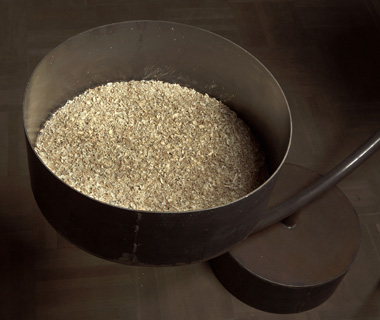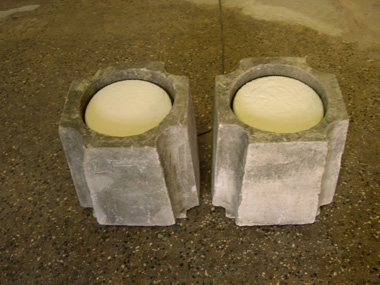This review was one of the finalists in Circa’s critical-writing competition for undergraduates in Ireland; more information here .
 |
Miroslaw Balka, BlueGasEyes, (detail), 2004, Steel, salt, DVD projection, loop, sound 27min., Dimensions variable, Courtesy the artist and Gladstone Gallery, New York / IMMA |
The first law of thermodynamics states that energy can not be created or destroyed, it can only transmute from one form to another, conducted or transmitted within a closed system. As we both visually and physically engage with objects and their coordinates within a gallery we see how certain feelings can pass through us on entering a space; we are affected by a certain energy, we find this resonance, this palpable sensation of receiving an intended transmission. Hard to explain, yet it cannot be denied, taking the form of a kind of mysterium fidei [1]. Miroslaw Balka’s Tristes tropiques installation at IMMA is the perfect example of this phenomenon. The works, in form, carry respectable credentials referencing Russian constructivism, Joseph Beuys, and post-war American Minimalism. With stark allusions to the Second World War, the artist’s own unique personal, geographical and cultural attributes are also evident, yet somehow the works transgress the mere sum of their parts both critically and physically; their appearance and the spaces they inhabit can only be described as uncannily haunting, an experience which I would personally compare to that of passing through the horrifically sublime [2], desolate spaces of a Nazi concentration camp.
 |
| Miroslaw Balka, 215 x 135 x 60, detail, 2005, Steel, Calliphora vicina maggots, 215 x 135 x 60cm, Courtesy of the artist and Jay Jopling/White Cube, London / IMMA |
The places a stain can take your mind, filamentary human traces crafted, or marking inanimate surfaces, ropes of human hair and soap, the placing of a pipe or trough, and the contents that lie within: all signs and indications of the transmutation of energy, the passage of time, the marks of labour, disembodied remnants of decomposition and intention.
Memory and aesthesia constitute our experience as we pass through this deeply unsettling yet familiar space. Stripped back to elemental composites, both corporal and geographical, salt, gas [3], and water, the installation creates a sense within us that somehow what we are made of, what is to be found and extracted from the depth of our worlds, physically and mentally is somehow truly repulsive and terrifying to us. We are confronted with History and Reality simultaneously.
 |
Miroslaw Balka, 3 x (57 x 50 x 50), 2003, Concrete, salt, revolving mechanism, 3 x (57 x 50 x 50)cm, Courtesy of the artist and Gladstone Gallery, New York / IMMA |
Perhaps it is the artist’s conversant understanding of suggestion, and the resuscitation of cultural memory, or maybe it is something more mysterious; however, the affect remains unquestionably potent.
A trace that clasps an intimation of human potential [4], and the ethics that judge and govern our experience of it.
Alice Rekab is …
1. Latin phrase meaning mystery of faith; a Christian theological term for an article of faith or doctrine which defies man’s ability to grasp. (I reference here the artist’s Polish Catholic upbringing.)
2. Sublime : Schopenhauer: The feeling of the sublime is pleasure in seeing an overpowering or vast malignant object of great magnitude, that could destroy the observer. Sublime : chemistry:convert solid substance to gas: to convert a substance directly from a solid to a gas or from a gas to a solid without an intermediate liquid phase, or undergo this process. Here I am referencing the artist’s use of traces of the conversion tangible physical substances into intangible yet palpable gaseous humour. ( Humour : historical meaning => body fluid; according to medieval science and medicine, any of the four main fluids of the human body, blood, yellow bile, black bile, or lymph, that determined somebody’s mood and temperament => Current meaning: an emotional state. For example: m elancholy : fourteenth-century, directly or via French mélancholie < late Latin melancholia < Greek melankholia < melan – ‘black’ + khol? – ‘bile’.)
3. Gas : The word gas was proposed by the seventeenth-century Flemish chemist Jan Baptist van Helmont, as a phonetic spelling of his Dutch pronunciation of the Greek word’chaos’, which was used since 1538 after Paracelsus for ‘air’.
4. Potential energy can be thought of as energy stored within a physical system. This energy can be released or converted into other forms of energy, including kinetic energy. It is called potential energy because it has the potential to change the states of objects in the system when the energy is released.